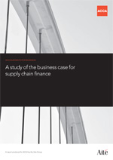This report is aimed at CFOs and FDs considering the business case for supply chain finance. It provides a checklist of costs, risks and complications to be considered, and a breakdown of how the benefits from such facilities are distributed.

In November 2011, the UK government announced the creation of an industry taskforce to examine the potential for creating better access to alternative credit channels for SMEs and mid-market companies. The taskforce, chaired by Tim Breedon, published its report the following March, naming professional accountancy bodies, including ACCA, as the British government’s natural partners in accelerating the adoption of supply chain finance.
Supply chain finance is broadly defined as the use of financial instruments, practices and technologies for optimising the management of the working capital and liquidity tied up in supply chain processes between business partners.
In February 2014, ACCA’s Global Forum for SMEs cited reverse factoring in particular as one of the most promising tools for financing small businesses around the world, and noted the growth potential in the sector, which currently makes up only 4% of the global receivables financing market.
This report, prepared by Aite Group, was commissioned as part of ACCA’s commitment to the promotion of supply chain finance at the global level. It is aimed primarily at senior finance professionals and is meant to function as a learning resource and a reference text. But it also aims to add to the body of knowledge on supply chain finance in two ways.
First, it estimates the global market size for reverse factoring, arriving at a global total of between US$255bn and US$280bn, 20%–25% of the typical industry’s value of accounts payable.
Second, it offers a first-ever breakdown of how the benefits from such facilities are distributed between suppliers, buyers and finance providers. On average, the researchers find that 80% of the resulting value is shared between the suppliers and the buyer (with the buyer generally benefitting slightly more), while another 15% goes to the financial intermediary and the remaining 5% is for the service provider.


